Cane Corso is a great working dog. Since ancient times, it has been serving people, helping people protect their houses as a guard dog, detaining criminals, and even fighting. Anthropological scientists claim that it is the Cane Corso Italiano that is the most ancient breed of dog in the world, and all other dog breeds originated from it.
Here’s a comprehensive look at the Cane Corso, combining the insights from the provided responses and addressing potential shortcomings:
The Cane Corso: Ancient Origins, Powerful Presence, Loyal Guardian
- Historical Roots: Descended from the legendary Molossus war dogs of ancient Greece and Rome, the Cane Corso embodies a lineage of strength, protection, and resilience. Through the centuries, they served as farm guardians, hunters, and even gladiator companions in the arenas of Rome.
- Modern Revival: After near extinction following World Wars I and II, dedicated enthusiasts revived the breed in the 1970s in Italy. Their careful efforts preserved the Cane Corso’s unique qualities and led to recognition by major kennel clubs like the AKC, FCI, and ENCI.
- Impressive Appearance: These large, muscular dogs command attention with their powerful physique, broad head, and alert expression. Their short, stiff coat comes in various colors, including black, gray, fawn, and brindle, sometimes with black or gray masks.
- Loyal and Intelligent: Cane Corsos form deep bonds with their families and possess a fierce protective instinct. Their intelligence and eagerness to please make them highly trainable companions.
Important Considerations Before Bringing Home a Cane Corso
- Not for Everyone: While magnificent dogs, Cane Corsos are not suited to first-time owners. They demand experienced handling, consistent training, and a committed lifestyle that matches their energy and protective nature.
- Thorough Socialization: Early and extensive socialization with humans and other animals is paramount to prevent overprotectiveness or aggression.
- Exercise is a Must: This is a working breed. They require substantial daily exercise and mental stimulation to thrive. A fenced yard provides safe play space, but walks and structured activities are also essential.
- Responsible Ownership: Due to their size and strength, responsible ownership involves meticulous training, understanding their potential for aggression, and ensuring you provide the necessary guidance and environment.
Health and Care
- Potential Health Concerns: Like many large breeds, Cane Corsos can be prone to hip dysplasia, eye problems, and other health issues. Choose a reputable breeder who prioritizes health testing and can provide a health history.
- Balanced Diet: A high-quality diet tailored to large, active breeds is essential to maintain their health and energy levels. Overfeeding can lead to obesity and related issues.
- Grooming: Their short coat requires relatively low maintenance, with regular brushing to reduce shedding.
- Veterinary Care: Maintain regular vet checkups, vaccinations, and parasite prevention to ensure your Corso’s long-term well-being.
Training and Temperament
- Early Training is Key: Start basic obedience and socialization as a puppy to establish a strong foundation and positive behavior patterns.
- Positive Reinforcement: Cane Corsos respond best to praise, treats, and play-based motivation. Harsh training methods are ineffective and counterproductive.
- Firm and Consistent Leadership: Your role as the confident leader is crucial for managing their dominant tendencies and ensuring a well-adjusted dog.
- Mental Stimulation: Agility training, puzzle toys, and other activities challenge their minds and prevent boredom.
Cost and Commitment
- Finding a Reputable Breeder: Choosing a responsible breeder ensures a healthy, well-socialized puppy. Cane Corso adoption from reputable rescues is also an option. Expect to invest significantly in your new companion.
- The Long Haul: Cane Corsos have a typical lifespan of 10-12 years. Be prepared for the financial and emotional commitment of caring for them throughout their lives.
The Cane Corso is a magnificent breed with a rich history. If you have the experience, resources, and dedication to provide a structured, loving home, a Cane Corso can be a loyal and rewarding companion.
Remember, thorough research and honest self-assessment are key before welcoming a Cane Corso into your life. Seeking the guidance of breed experts and reputable breeders can ensure you make the best decision for both you and the dog.
As per the Fédération Cynologique Internationale, the Cane Corso dog breeds were onetime distributed throughout the Italian peninsula, however, in recent history was found just in Puglia (Southern Italy). These dogs are quite different from other breeds. So, here let’s know more about Cane Corso’s large dog breeds.
- Breed Name: Cane Corso
- Country of origin: Italy
- Healthy Dog’s Weight: Males 45-50 kg, Females 40-45 kg
- Height: Males 64-68 cm, Females 60-64 cm
- Life Span: 9-11 years
- Type: Large or giant breeds of dog
- Used As: Working Dog, Guard Dog, Bodyguard dog
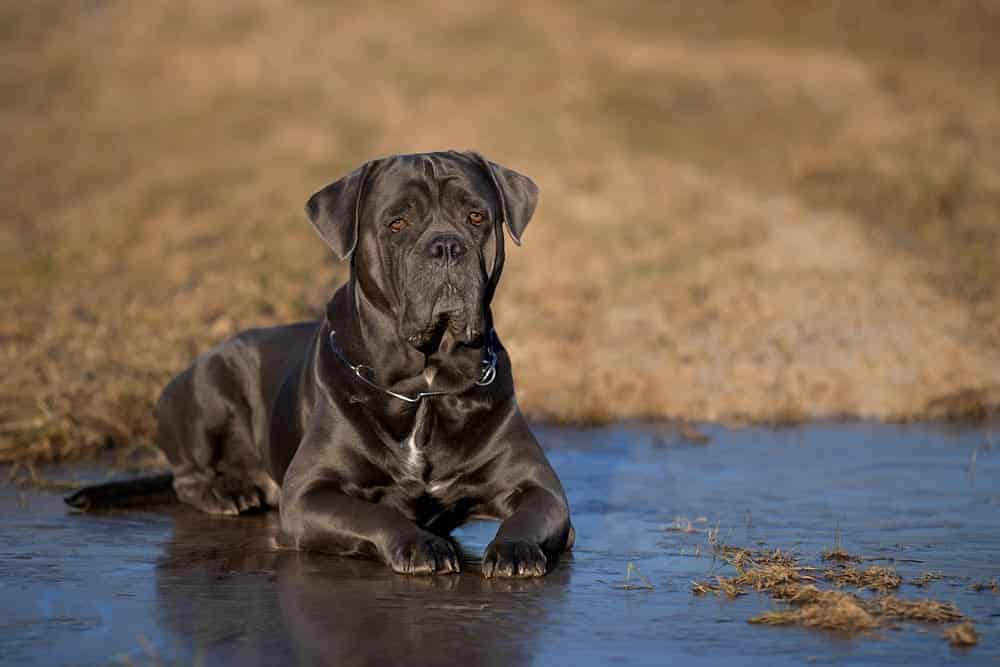
Origin of the Cane Corso Puppies:
The history of the Cane Corso dog breed is like a historical thriller. Italian mastiff is officially recognized as their ancestors, distinguished by their large size and ferocity. Studies show that the first representatives of the Cane Corso appeared in the second millennium BC, and they were brought to Europe by the soldiers of the Roman Empire 300 years before the birth of Jesus Christ.
An interesting history of the breed goes back to ancient times. The Cane Corso’s ancestors served as guards against wild boar and surrounding enemies. The closest ancestor to the type of Cane Corso that exists now is the Tibetan Great Dane, bred three thousand years ago. The territory of their origin is now called Eurasia.
Over time, the breed went beyond its range and changed by crossing with other breeds. Most often they were used for protection. Cane Corso is documented from the XIV-XV centuries. Their hunting service was described, and other individuals were used as shepherds. All this is captured in the annals, but there is an approved history of the appearance of Corso dogs as a breed much earlier – the roots go back to the heyday of the Roman Empire.
Appearance Of Cane Corsos:

This large dog breed looks like a real wrestling dog: strong muscles, and a strong physique. Adult Dogs look into the best traditions of charismatic and temperamental Italy. They are serious, fast, dexterous, with an ardent character, and the elegance of their movements is similar to that of a cat.
Head:
The head of the Cane Corsos is its most significant feature. It’s square, large, impressive, and commands respect. It is what gives the adult dogs tremendous presence that as soon as Cane Corsos are in the room, you’ll know it.
Ears:
By nature, the Cane Corso’s ears are slightly large and set wide apart, set close to the head. Covered with smooth and shiny dog hair, they, tapering towards the ends, hang down, adjacent to the dog’s cheeks. They can be stopped by giving the shape of an equilateral triangle.
Neck:
Another example of the combination of grace and strength of these Roman war dogs, Cane Corsos are the neck. It’s powerful, embossed, and organically appears like the dog’s body, however, similarly graceful, flexible, and also noble. The length and size are similar to the dog’s head’s length.
Torso:
In contrast to the body length, the height of the dog at the withers is somewhat shorter. The croup is voluminous, the withers rise above it and therefore are quite noticeable
Tail:
In these large dogs, the tail length reaches the fold line of the hind limbs. Set high on the body, tapering towards the end. The powerful structure of the Cane Corso does not provide the ability to bend and raise the tail.
Wool:
The skin fits tightly over the bones but does not create a painful appearance. The rough structure of the fur, not long hair, and a shiny, glossy appearance indicates that they are a pure breed.
Cane Corso Size:
The length of the body exceeds the height of the dog in parameters (at the withers). On average, the growth of Cane Corso in females is 60-65 cm, and in males – 61-55 cm.
Paw:
The paws of the Cane Corso are moderately muscular, with well-defined shoulder blades and excellent joints.
Since these dogs were bred for herding livestock, they got such an appearance to herd livestock. However, being a working breed, they need proper training, early socialization, lot of mental and physical stimulation, to become great companions to pet owners. Moreover, if you are not experienced pet parents and can’t handle Cane Corso cost, then it is better to adopt other dogs.
Popular Cane Corso Colors:
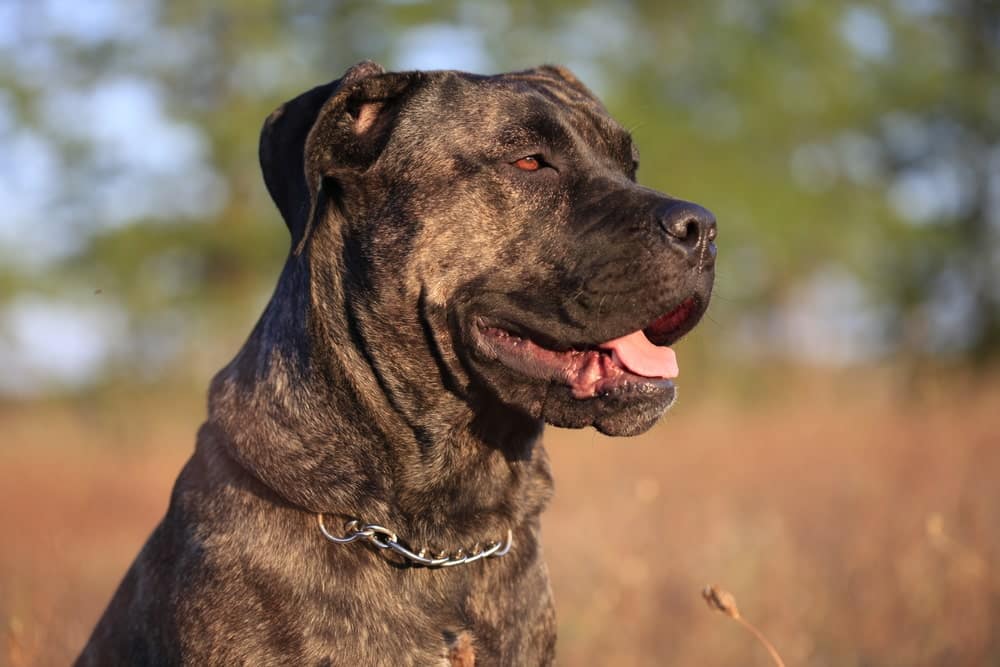
Different colors of these giant breeds are allowed. Some of the colors are considered rare, and dogs of this color are used with pleasure in breeding work. Other colors, on the contrary, are culling, and they try to get rid of such puppies. Currently, you can find Cane Corsos in the following colors:
White:
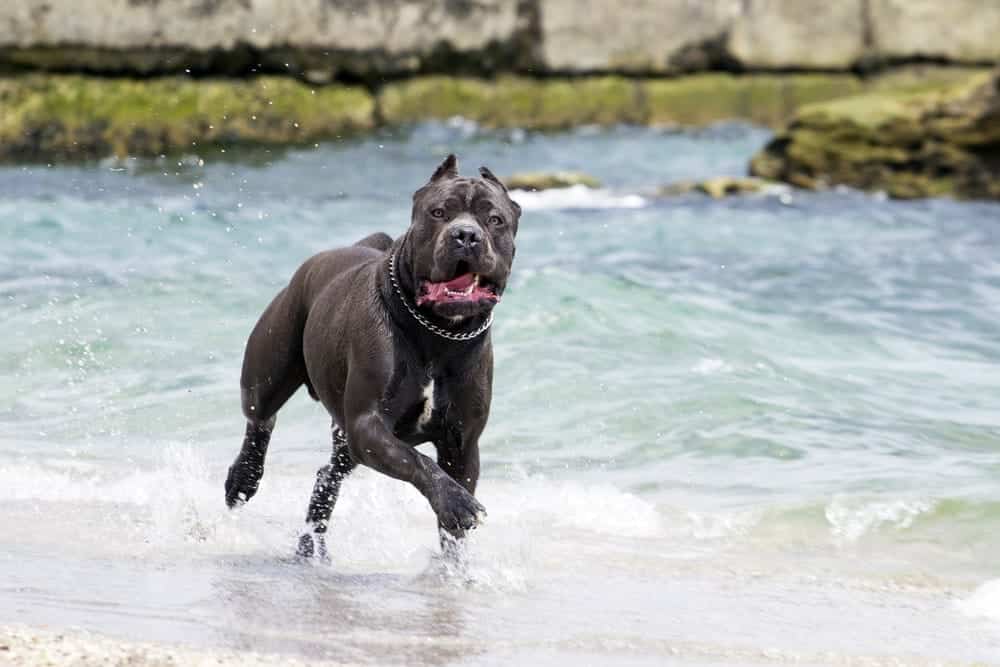
This color is considered the most undesirable of all. Dogs of this color are born as a result of incorrectly selected mating pairs. Thus, these dogs may have a life-threatening stomach condition and also gum disease. Responsible breeders or Reputable breeders pay close attention to it. Thus, it is always recommended to get a dog from only a reputable breeder who can give you a generally healthy dog.
Ginger:
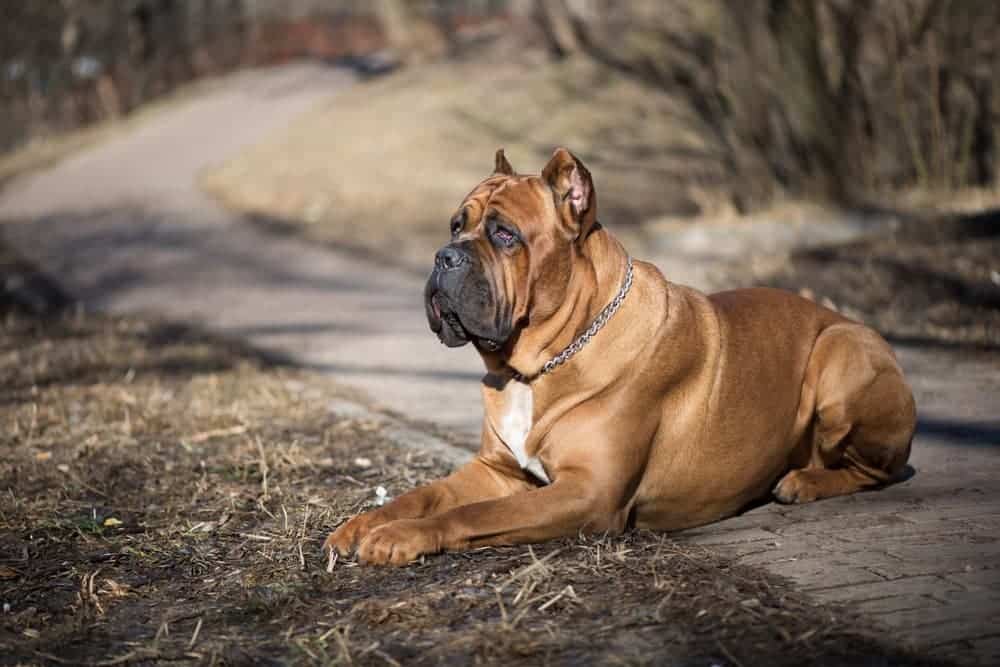
There are dogs of dark red or light red color. Both shades are acceptable and popular among reputable breeders. Usually, the red stiff coat color is passed down through the maternal line.
Grey:
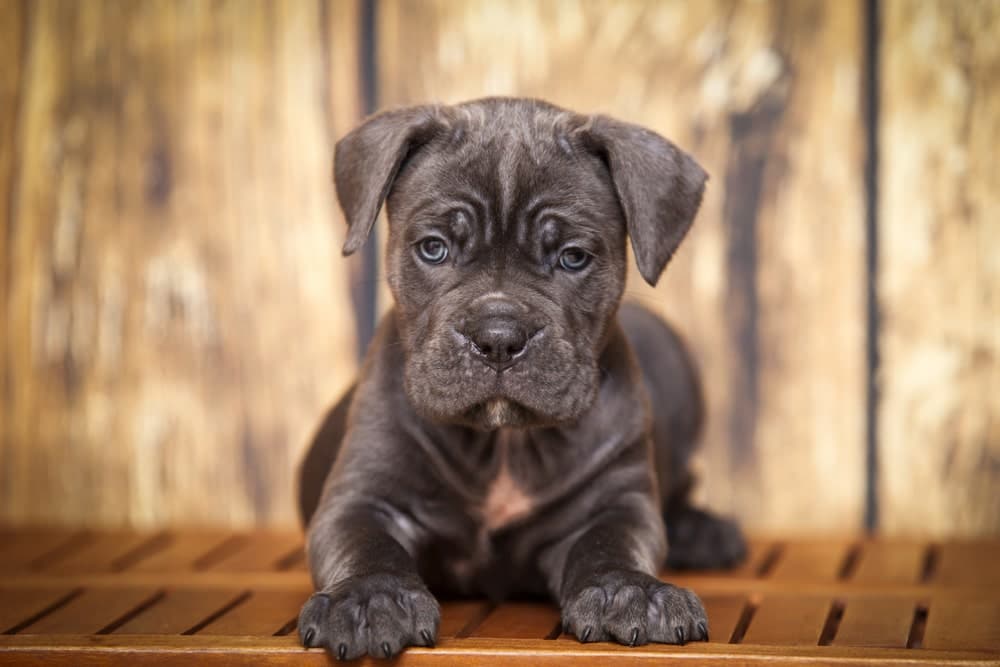
The most popular color of these intelligent dogs. The color scheme can range from light gray to dark. A dog of this color looks the most impressive and menacing. Such big dogs are very often shown at exhibitions and filmed in advertisements.
Brindle:
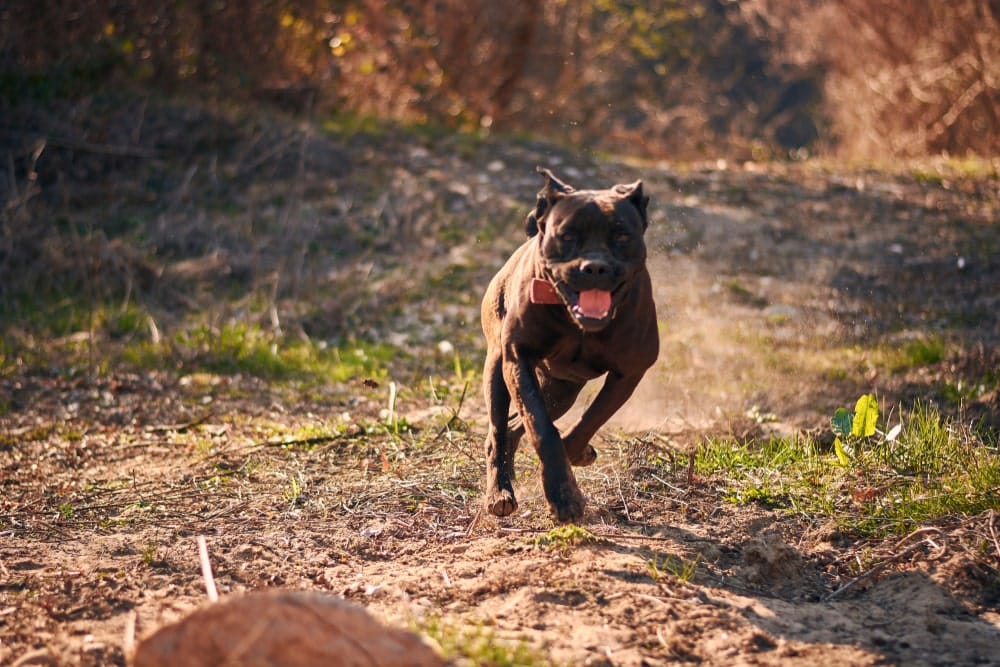
The coat of such dogs can be light or dark red, and black stripes run along it, making the dog look like a small tiger. The similarity is also given by the feline plasticity that Cane Corso possesses. They can also have a black or gray mask.
Black:
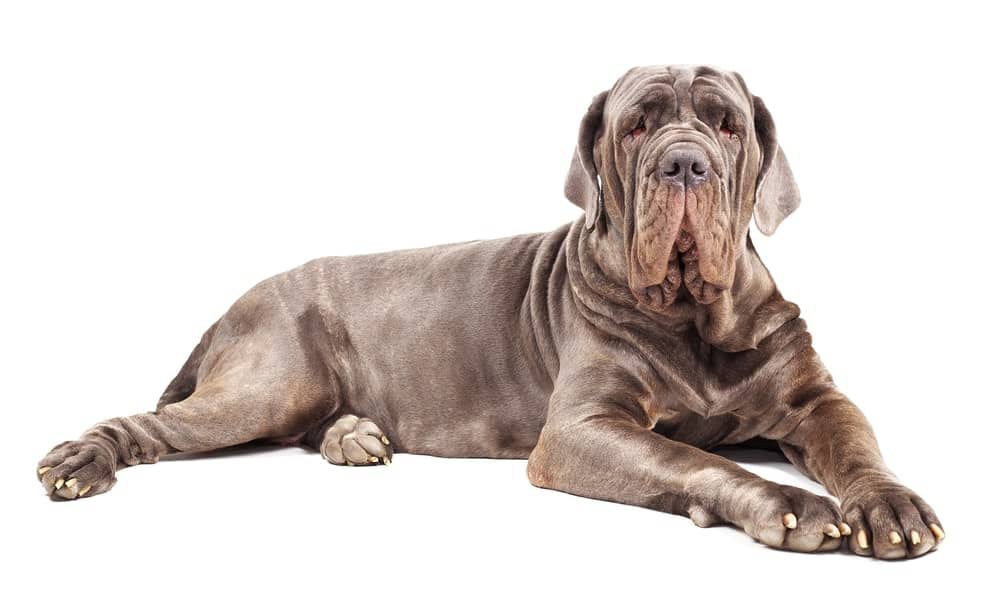
This is a living classic of the Cane Corso dog breed. Initially, all dogs of this breed were black and therefore this color is considered a reference. This color makes the ideal dog breed. They often seem to work in rescue groups.
Nature Of The Cane Corso:

Trainable, smart, and of dignified bearing, the confident and assertive Cane Corso is a great protector. At about 28″ at the shoulder, Cane Corso often weighs over 100 pounds. Cane Corsos have large heads, attentive expressions, and muscles splashing beneath their stiff, short coat. A Cane Corso dog is an intimidating creature at a glance. Their imposing look is their foremost line of protection against intruders.
A Cane Corso dog is loyal, intelligent, versatile, eager to please, and also intensely devoted than other animals, but is also willful and assertive which goes perfectly with all family members of the house they live.
As with any other big protection dog, responsible breeding as well as early socialization is vital for them. Moreover, exercise Cane Corsos are important because they were bred for activity. A Cane Corso may be black, with various hues of grey (light grey, slate-grey, or lead-grey) or fawn (light fawn, stag red, or dark fawn), or dark wheaten; it may also be brindled.
Training & Education:
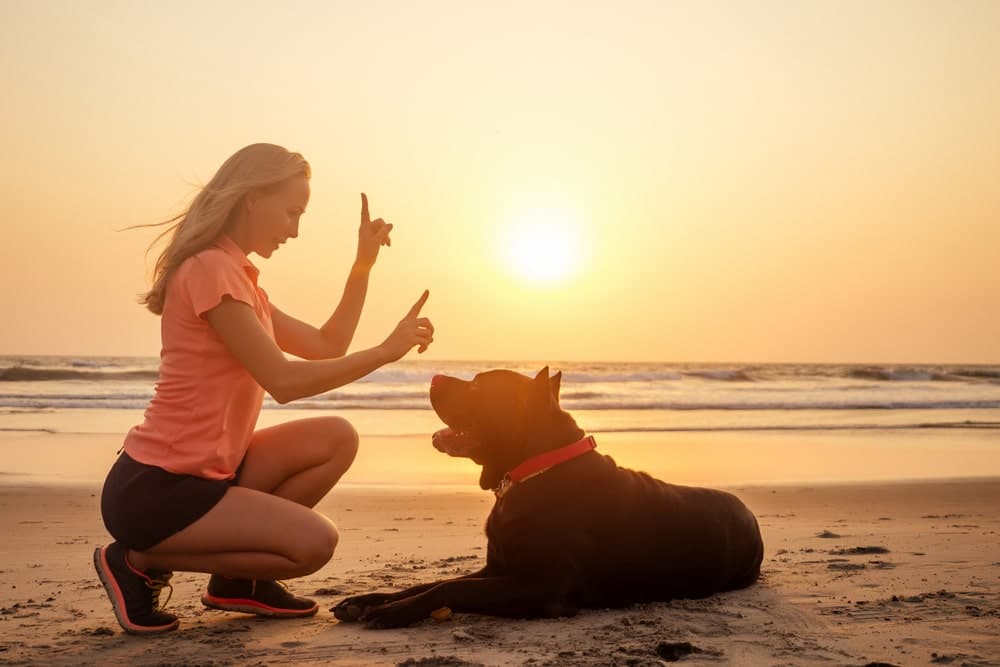
The age of 2-13 weeks is the most sensitive Cane Corso dog learning period of a Cane Corso puppy. “Research indicates that behaviors discovered during this age have a higher tendency to adhere throughout the life of a Cane Corso more than at any age of dog training. Here is a dog training timeline for Cane Corso to help you know when to train what.
8 to 16 Weeks
Bond With Your Cane Corso: By 8 weeks, your dog is ready to leave their littermates and parents and come to live with the pet owner. Building a strong bond with your dog starts from this moment.
Proper Socialization: A vital socialization window generally lasts until the Cane Corso is about 16 weeks, so it is significant to socialize the Cane Corso dog early by introducing them to other animals, new people, sounds, sights, etc.
Crate Training: A crate will offer your dog a quiet place. Here, the dog lives with a safer feeling. It is most acceptable to introduce your dog to the crate right away as well as begin building cheerful associations with dog food, dog treats, and dog toys. If they are left unsupervised they may become aggressive.
House Training: When you bring the dog home, introduce it to its designated area where it can perform its business, and then walk (at least a mile) or carry it to that particular area every single time you take it out of its crate.
Obedience Training: Although smart, Cane Corsos are not exactly familiar with being eager to stay alone and they quickly get bored. So keep sessions short, fun, and exciting training, reinforcing obedience as well as desired behavior along with high-value dog’s food as a treat and lots of praise.
Care and Maintenance:
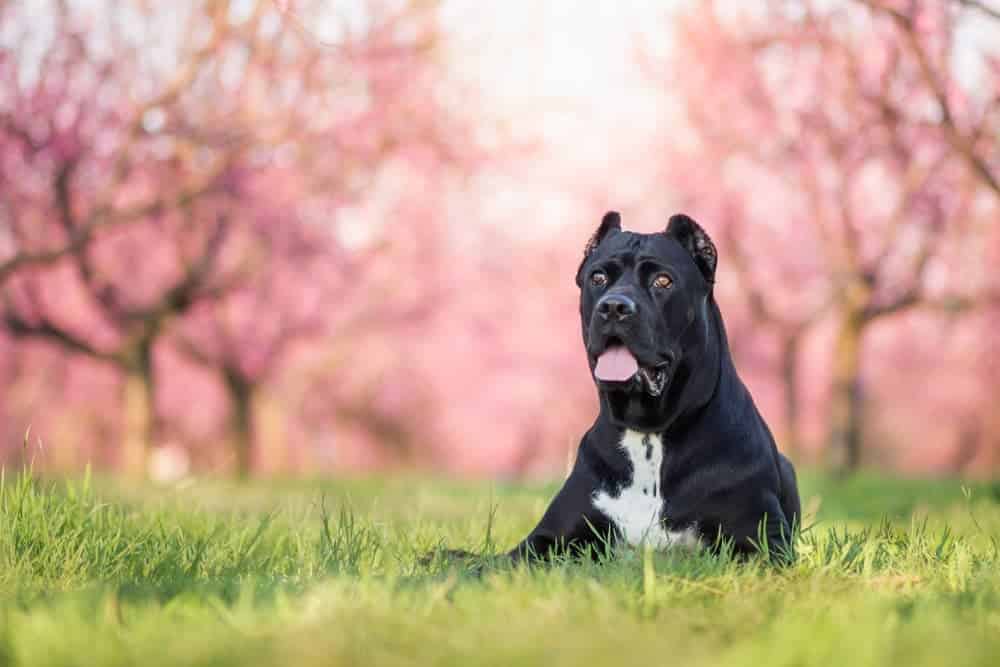
The existing characteristics of the Cane Corso breed and the reviews of experienced dog breeders allow us to conclude that with proper walking, the Corso will feel good in any living space. Year-round keeping outdoors is not recommended.
If the animal is in the aviary in winter, he needs to provide a warm place to sleep. This is a shorthaired breed. She has a small undercoat, but it will not warm in cold weather. Corso is also not suitable for the role of a chained dog.
Coat care, weekly brushing, and daily brushing during shedding season—using a medium-bristle brush, a rubber grooming mitt, or using a hound glove will clear dead hair before the hair can fall onto your furniture. These breeds need extra care than other breeds and even more than small dogs. To fight the bad odor of dogs, bathe your dog often.
These powerful dogs appreciate skills training, agility training, dock diving, etc. that keep their body fit and mind enriched. They must get a brisk walk, in the morning and in the evening to stay healthy. If you do not have enough time then teach children to take them for a walk daily.
Pay attention to your dog’s shoulder, weight gain, new hair growth, and double coats, and check ears weekly to maintain the healthy growth of your dog. Also, these dogs require regular mental stimulation. So, you also need to pay attention to their mental stimulation. The only factor that is most important is that they need regular exercise. So, never miss their exercise session.
Feeding and Diet:
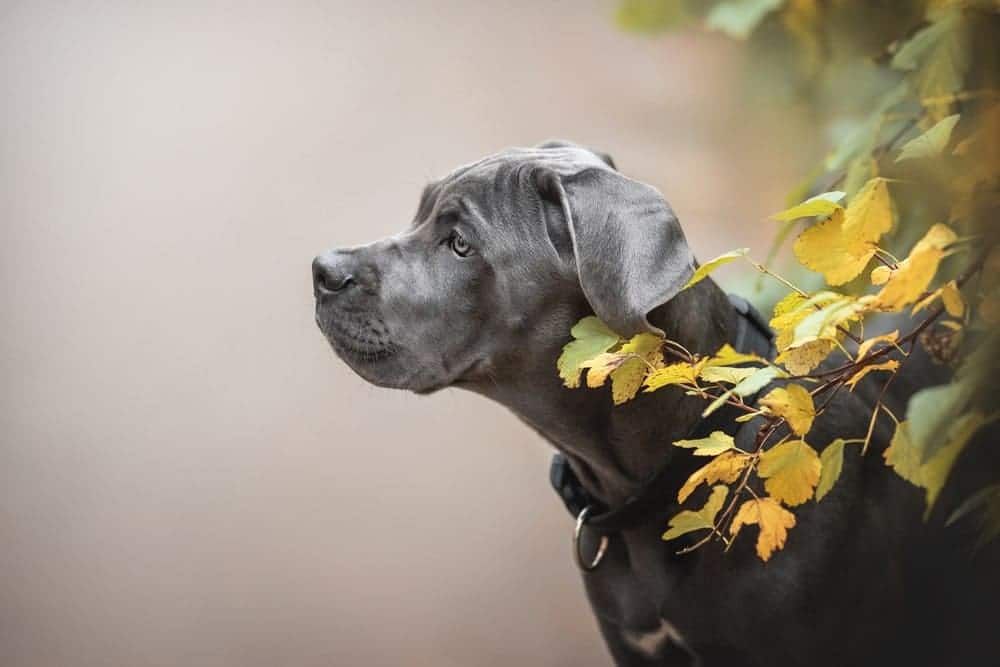
Carne Corso is designed for vigorous dog sports, exercise, for running – so it burns a large number of calories. But if you do not run around the park with your pet and take him to lie on the couch for company, there is a problem with overweight, disruption of the gastrointestinal tract, and the musculoskeletal system.
Physical activity or powerful dog sport and the dog’s natural diet will help prevent trouble. If there is a need to switch Corso to dry food, choose premium food, not lower. This is quite expensive, but cheap Cane Corso dog food will not work – allergies or serious disorders of the digestive tract may appear. Determine the allergen by elimination and remove it from the diet.
In the daily diet of a Cane Corso puppy and an adult, foods containing proteins, fats, carbohydrates, minerals, and vitamins should be present. It is worth starting to feed the Cane Corso breed from birth 6 times a day, gradually reducing the number of meals. An adult Cane Corso should be on two meals a day, although meals are allowed once a day.
Basic Rules For Feeding:
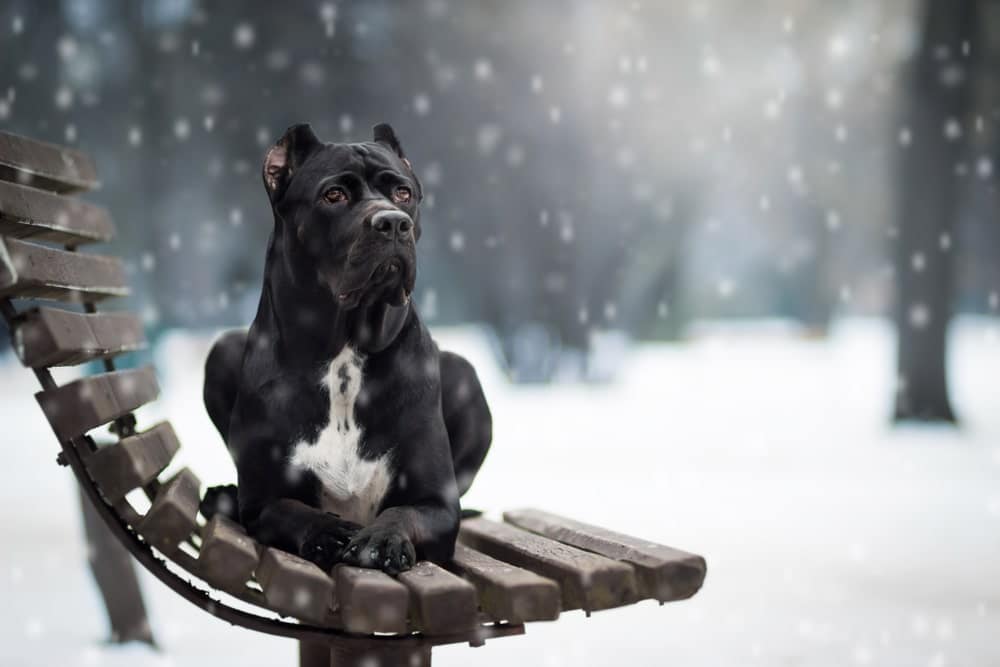
From the first days of being in a new home, a baby Cane Corso should immediately get used to food and order. To do this, you must adhere to the following rules:
- The bowl of food should be placed on a vertical stand with a stable base. The dishes, therefore, are at the level of the pet’s chest or slightly higher so that he does not have to tilt his head.
- The bowl should be inserted into a metal hoop and fixed with a ring or clip.
- The dog’s bowl stands should be wide and stable.
- It is recommended to increase the rack in the process of growing up a puppy.
- Food should be poured into dishes made of ceramic, aluminum, or enameled material.
- A small rug should be placed under the paws so that the dog does not slip on the floor while eating.
- The volume of the Cane Corso puppies bowl should hold 0.5 kg of dry food or 500 ml of liquid.
- The dishes must be selected without defects and potholes to prevent injury.
- Washing dishes is usually done with warm water and soap or soda, after which they must be thoroughly rinsed under running water.
What Type Of Food To Choose:
Nutrition for the Cane Corso is selected taking into account its age, weight, and physical activity. To maintain strength and energy, the Cane Corso owners should choose a balanced diet. The composition must include proteins, fats, carbohydrates, mineral elements, and vitamins.
Natural Products:
Many Cane Corso owners feed their pets with natural products just like other pets. To do this, you need to know about their use and prohibited types.
Allowed Foods Include:
You can diversify the dog’s diet with such products:
- Chicken and rabbit meat, beef;
- Offal;
- Boiled sea fish;
- Cow and goat milk;
- Cottage cheese, kefir, yogurt;
- A small amount of vegetable or butter;
- Wheat, corn, rice, oatmeal, barley, and buckwheat porridge;
- Carrots, potatoes, beets, cabbage;
- Fruits and berries;
- Seaweed.
Prohibited Foods Include:
- Pork;
- Salo;
- Tubular raw and boiled bones;
- Chicken and goose skin;
- Smoked products, marinade, spices, pickles;
- River fish;
- Pastries and sweets.
How Much and How Often To Feed?
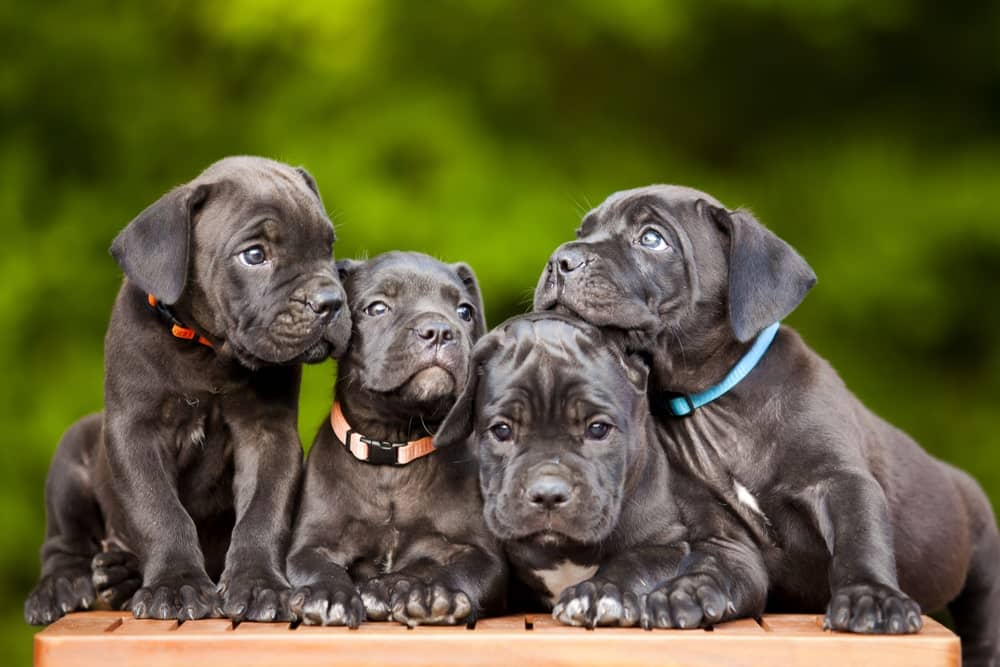
It is worth using high-quality super-premium food. It is based on meat products and cereals. With a high activity of an adult Carne Corso, the portion of food should be 530-550 g per day, with a low activity of 380-440 g.
Health Conditions and Disease:
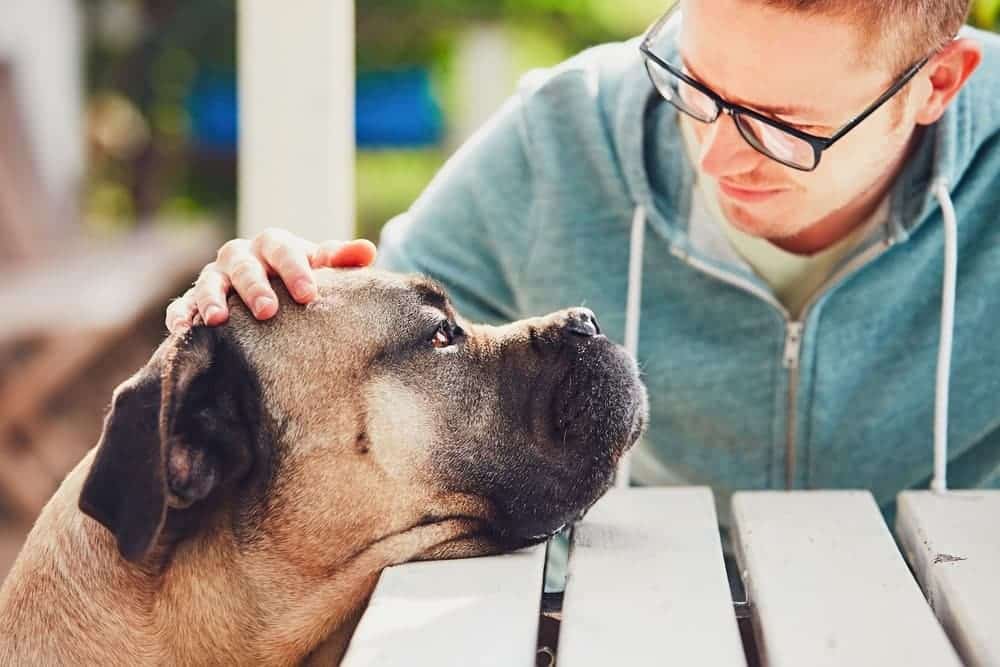
Each breed of dog has a predisposition to certain diseases. We have collected information about the typical diseases of the breed. Remember the symptoms of the disease, and the risk that every pet has, and then you can help him promptly.
Cane Copromptlygreat friend and protector, he is a real national treasure and pride of Italy. His character reflected the most vivid emotions of temperamental Italians: courage, selflessness, strong character, devotion, and active life position.
This breed is prone to hereditary diseases. Most often, the Italian dog suffers from congenital dislocation of hip dysplasia. The disease is not treatable, in extreme cases the dog has to be euthanized. Even professional cynologists do not always see this disease in a puppy, especially since there are no ways to predict it. There is alwX-rayn an opportunity to carry out an X-ray procedure, but it will not give one hundred percent insurance.
An allergy is an immune system reaction caused by an allergen. Allergens include food, as well as proteins of plants, animals, and insects.
The reaction of the immune system can adversely affect the body of the Cane Corsos. Over several years or months, periodically the allergen can increase sensitivity and cause an overreaction of the immune system. Most often, the body protects the animal from infections, but the reaction of the immune system will have a devastating effect on it.
Allergic reactions are rather difficult to tolerate. Allergen molecules combine with antibodies in the blood and then attach to mast cells. These cells are found throughout the body in animal tissues. The reaction of antibodies and antigens with mast cells causes a substance that has a very strong effect on the body. For example, histamines, cause inflammation in the form of itching, swelling, and redness of the skin of a pet. Such inflammation leads to signs of an allergic reaction.
The animal’s face, lips, nose, eyelids, ears, or ear plugs may swell. Possible itching in the ears, eyes, and nose. Sometimes sneezing and coughing in a dog is a sign of an allergic reaction. Also, a symptom is a disease of the digestive tract, a sign of this is diarrhea and vomiting. There may be hives or red, inflamed skin.
In Cane Corsos, itching of the skin is most common, in one area (localized) or all over the body (generalized). Sometimes the symptom is accompanied by wheezing, sneezing, or even a complete violation of the respiratory system. Allergies can affect the digestive system, in such cases, diarrhea and vomiting are observed. There may also be a discharge (liquid form) from the nose and eyes.
Allergies are quite common in dogs, regardless of breed and origin. This is due to the fact that the number of substances that act as allergens. Most often, allergies appear in dogs that are six months old or affect a pet over the age of one or two years.
So, they can have health issues like eyelid abnormalities, idiopathic epilepsy, joint problems, and other health issues. These most popular breeds need proper care and attention to have a good fit in life. So, spend time with your Cani Corsi on a regular basis after you bring home this dog.
How To Choose a Cane Corso Puppy?
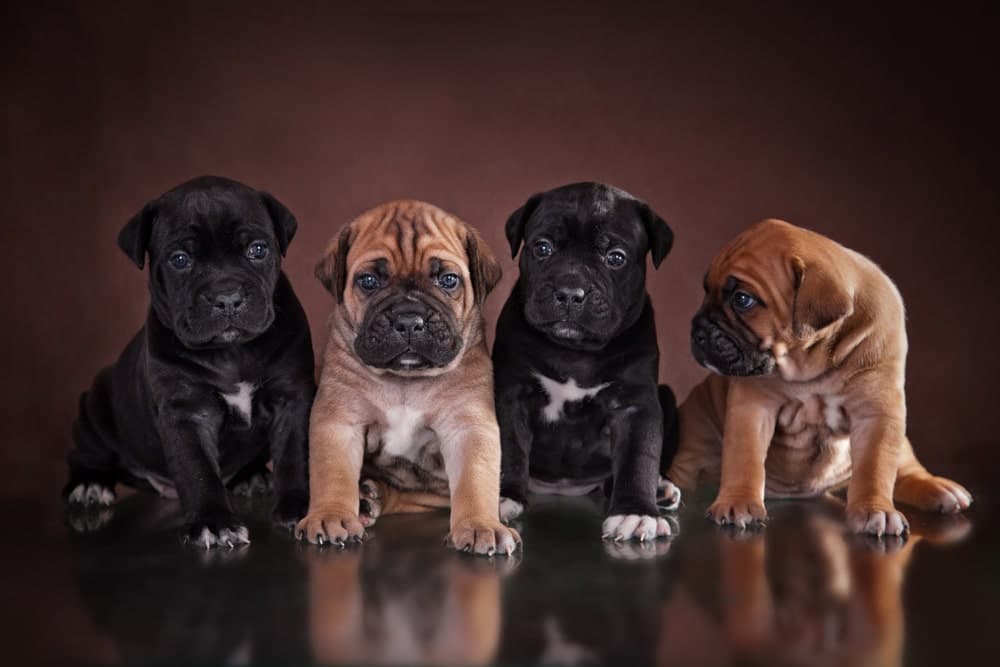
All Cane Corso puppies are very similar to each other dogs, and it seems that there is nothing difficult in choosing one of them. The one who will become an exemplary pet and a true friend for many years to come. This breed of dog is luxurious and expensive, therefore, before deciding to buy a Cane Corso, familiarize yourself with the nuances of the breed, and its features.
You should not choose a baby Cane Corsos only from a photo on the Internet among other dogs. Be sure to get to know him personally. It often happens that a handsome man from a picture suddenly does not have a soul. Oddly enough, professional dog breeders advise not to ignore intuition. Good, responsible breeders spend a lot of effort, time, and money on quality dog nutrition, providing ideal conditions for them, and veterinary procedures.
Considerable costs are associated with searches and trips to mating partners, who often live in other regions and even abroad. Add to this participation in various exhibitions, competitions, and contributions to specialized associations, and first-time dog owners will understand that a real Cane Corsos puppy cannot be cheap.
Carefully examine the puppy: its color, build, conformity of development and age, and condition of the skin and mucous membranes – there should be no sores, bald spots, or rashes. The mucous membranes should be clean, and pink.
If there is discharge from the puppy’s nose or eyes, this is a sign of health issues. It is also important how the little Cane Corso behaves. He must stand firmly on his feet in every sense: be bold, energetic, and friendly dogs.
All babies should be strong and well-fed. Watch them for a while. Take someone who is confident, brisk, s with gusto, but don’t overdo it. Too nimble cane corso puppy in the future may turn into a daredevil. Therefore, correlate your Cane Corso temperament with the character of the future pet.
Ask them to show you the puppy’s parents, or better, the father too. Evaluate how they correspond to the breed standard, and how they look in general. If the bitch seems tired, underfed or has genetic health problems, it is better not to take a puppy. It works just the way things work for other dogs.
A dog that has been little cared for during pregnancy is unlikely to produce healthy offsprearly socializationing. In addition, this eloquently characterizes the breeder. It’s better not to risk it. So, when choosing a pet, pay attention to:
- The cost of a puppy;
- The conditions in which the dogs live in the kennel;
- Availability of documents for the animal;
- Family tree;
- The appearance of the puppy and the exterior of the dog;
- The behavior and manners of the breeder himself.
How much does a Cane Corso Cost?
The price of a Cane Corso varies greatly, it starts from $150 and goes up to $1,000. The cost depends on the health of the puppy, purebred and physical development. It is possible to acquire a Cane Corso for a small price with a pure pedigree line, without impurities, but the health of such an individual may be undermined. In a local animal shelter, dogs are purchased at a low price, but this is a matter of luck. It is dangerous to rely on the quality of the breed without a puppy passport.
To avoid problems, buy a Cane Corso from an experienced breeder or specialized nursery with all the documents such as recognization from American Kennel Club, National Breed Club, Parent Breed Club, etc. Begin your cane corso dog search via the Cane Corso Association of America.
Conclusion:
Cane Corsos are cute and love to play like digging holes, running, etc. Just give them free rein to frolic – especially cane corso puppies up to a year old. With age, ardent Italians cool down to games and treat entertainment more calmly, but sometimes they don’t mind running after the ball.
These intensely loyal dogs are popular breeds from ancient Rome that have a muscular appearance. However, these dogs can have serious health issues so you need to get health clearances from the reputed breeder by doing some vital health tests.
FAQ
What is a Cane Corso lifespan?
The lifespan of a Cane Corso is typically between 10 and 12 years. This is slightly longer than the average lifespan for a dog of a similar size, but shorter than that of smaller breeds.
Are Cane Corso allowed in apartments?
Yes, Cane Corsos can live in apartments if they are properly trained and exercised. Cane Corsos are large, energetic dogs that need plenty of space to move and play, but they can adapt to apartment living if their needs are met.
How fast is a king Corso?
They are capable of running at speeds of up to 35 miles per hour, which is comparable to the speed of other large, athletic breeds such as greyhounds and German shepherds.
Cane Corso KC registered?
As a breed, Cane Corsos are recognized and registered by the KC and other major kennel clubs.
Is Cane Corso hypoallergenic?
No, Cane Corsos are not considered to be hypoallergenic. Hypoallergenic dogs are dogs that are less likely to cause allergic reactions in people who are sensitive to dog dander, saliva, or other allergens.
Are cane corsos allowed in Canada?
Yes, Cane Corsos are allowed in Canada. Cane Corsos are recognized by major kennel clubs around the world, including the Canadian Kennel Club (CKC)
Can my Cane Corso eat raw eggs?
It is generally safe for Cane Corsos to eat raw eggs. Raw eggs can provide your dog with a number of health benefits, such as improved coat and skin health, increased energy levels, and improved immune system function.
Can Cane Corsos have bananas?
Yes, Cane Corsos can safely eat bananas. Bananas are a healthy, low-calorie snack that can provide your dog with several important nutrients, such as potassium, vitamin B6, and vitamin C.
Can cane corsos eat blueberries?
Yes, Cane Corsos can safely eat blueberries. Blueberries are a healthy, low-calorie snack that can provide your dog with several important nutrients, such as vitamins C and K, fiber, and antioxidants.
Can Cane Corso eat cooked meat?
Yes, Cane Corsos can safely eat cooked meat. Cooked meat can provide your dog with a high-quality source of protein and other essential nutrients that support their growth and development.
Can Cane Corso eat apples?
Yes, Cane Corsos can safely eat apples. Apples are a healthy, low-calorie snack that can provide your dog with several important nutrients, such as vitamins A and C, fiber, and antioxidants. But be sure to remove the seeds and stem from the apple before giving it to your dog
Can my Cane Corso eat raw chicken?
It is generally safe for Cane Corsos to eat raw chicken. Raw chicken can provide your dog with a high-quality source of protein and other essential nutrients that support their growth and development.
Can cane corsos eat strawberries?
Yes, Cane Corsos can safely eat strawberries. Strawberries are a healthy, low-calorie snack that can provide your dog with several important nutrients, such as vitamins C and K, fiber, and antioxidants. But remove the stems and leaves from the strawberries
What’s the heaviest Cane Corso?
heaviest Cane Corso recorded was 343 pounds (156 kg) was called Zorba
Cost of Cane Corso in USA
On average, you can expect to pay between $1,000 and $2,000 for a Cane Corso puppy from a reputable breeder.
Is a Cane Corso bigger than a wolf?
NO, On average, a Cane Corso will weigh between 100-120 pounds, while a wolf can weigh between 50-180 pounds, with some individuals reaching weights of over 200 pounds.
How much is a Cane Corso puppy worth?
Cane Corso puppy worth anywhere between 1000 to 200 dollars depending upon breeder.

